Physics paper 2 questions
1/57
Earn XP
Description and Tags
Name | Mastery | Learn | Test | Matching | Spaced |
|---|
No study sessions yet.
58 Terms
An isolated solid conducting sphere is initially uncharged. Electrons are then transferred to the sphere.
State and explain the location of the excess electrons. (2)
They move to the outer surface of the sphere
They are equally spaced
Because electrons repel
Explain the function of the core in a transformer. (1)
Provides a greater magnetic flux linkage
Explain the function of the secondary coil in a transformer. (2)
Has an alternating magnetic flux passing through it
Produces an induced emf that is determined by number of turns in the primary and secondary coil

Explain how the efficiency of the transformer is increased by constructing the core in this way. (3)
Laminations made from high resistivity material - reduces eddy currents
Laminations of iron used - smaller emfs induced
Laminations of iron used - resistance increases, causing a decrease in eddy currents
What is meant by binding energy of a nucleus? (2)
Energy required to separate nucleus
Into individual nucleons
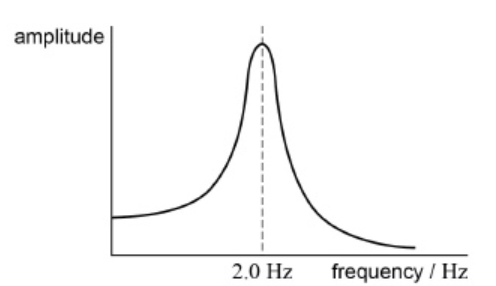
The graph shows how the amplitude of the oscillations of the mass varies with frequency for spring A.
The investigation is repeated with the mass attached to spring B with a spring constant of 3x spring A immersed in a beaker of oil.
A graph of the variation of the amplitude with frequency for spring B is different from the graph in Figure 2.
Explain two differences in the graph for spring B.
Peak will be at a higher frequency - due to a higher spring constant
Define the electric field strength at a point in an electric field. (2)
Force per unit charge
On a small positive charge
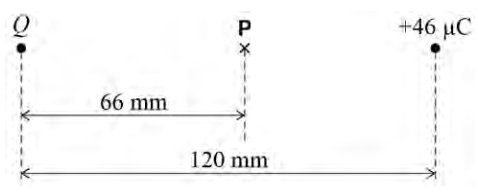
Explain, without calculation, whether net work must be done in moving a proton from infinity to position P (2)
Work must be done on a positive proton as P is at a positive potential
Potential at infinity is 0
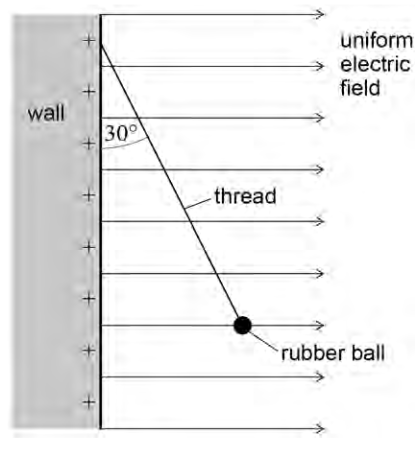
The thread breaks. Explain the motion of the ball (2)
Experiences both horizontal and vertical accelerations/forces
The acceleration is constant so it moves in a straight line
State Lenz’s law (1)
The direction of induced emf will oppose the change of flux creating it
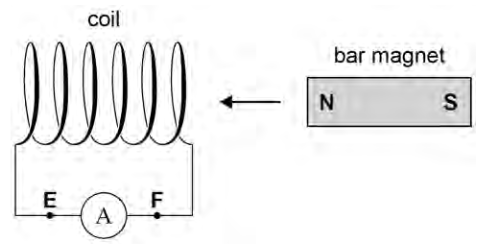
During the demonstration an induced current is detected by the ammeter. The induced current is in the direction E to F.
How does this demonstrate Lenz’s law? (2)
Current produces a north pole on the right-hand side of the coil
This opposes motion of the bar magnet
Define the tesla (1)
Strength of magnetic field that produces a force of 1N in a wire of 1m with 1A
A slow-moving neutron is in collision with a nucleus of an atom of the fule which causes fission.
Describe what happens in the process. (3)
A neutron is absorbed into a uranium nucleus
Causing the nucleus to split into 2 smaller daughter nuclei
Releasing fast moving neutrons
A thermal nuclear reactor produces radioactive waste.
State the source of this waste and discuss some of the problems faced in dealing wit the waste at various stages of its treatment, including:
the main source of the most dangerous waste
a brief outline for how waste is treated
problems faced in dealing with the waste, with suggestions for overcoming these problems (6)
Main source = control rods or fission fragments
Left to cool in cooling ponds for a number of years
Plutonium/uranium separated and recycled
High level waste vitrified
Stored in lead-lined containers deep underground
Waste is initially very hot - must be placed into cooling ponds
Waste initially very radioactive - needs to be screened and managed remotely
In liquid form it may leak - needs to be vitrified
Will be radioactive for thousands of years - needs to be vitrified and stored deep underground
People do not want waste to travel through places in which they live - trucks must be heavily lead-lined or could be processed nearby
What is represented by gravitational field lines? (1)
Direction of force on a mass
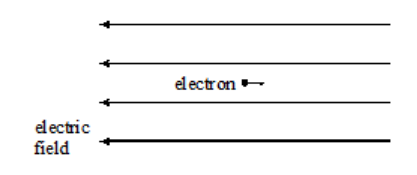
What is the direction of the force that acts on the electron due to electric field and what is the effect it has on its motion? (2)
To the right
Accelerates it
Describe how a beam of fast moving electrons is produced in the cathode ray tube of an oscilloscope (3)
Thermionic emission by heating
Cathode heated
Accelerated by electric field between anode and cathode
State and explain 2 reasons why the horizontal acceleration of a crushed particle containing 2 minerals falling through 2 parallel charged plates is different for each particle. (2)
Mass is not constant since particles mass will vary
Charge on particle is not constant
Acceleration = Eq/m
E constant but charge and mass are ‘random’
State 2 features of a geo-synchronous orbit. (2)
Fixed position relative to the surface of the Eart
Same angular speed as Earth
State 2 factors that affect the gravitational field strength at the surface of a planet. (2)
Density of planet
Radius
Explain why the values for gravitational energy are negative. (2)
Zero potential at infinity
Work done by the field in moving the object from infinity to that point
Impulse engines are used to place the satellite into an orbit with a longer period.
Discuss any changes this makes to the orbital motion of the satellite. (4)
Radius must increase
So velocity decreases
T² is proportional to R³
v² is inversely proportional to R
As a spacecraft approaches a comet, the speed can be reduced to match that of the comet. This can be done in stages using four ‘thrusters’. These are fired simultaneously in the same direction.
Explain how the propellant produces the thrust. (3)
Chemical combusion of propellant
Gas is expelled
There is a change in momentum of gases
Causing an equal and opposite change in momentum of the spacecraft
Thrust = rate of change of momentum
Explain the meaning of g and G. (3)
G is gravitational constant and g is the gravitational field strength
G is a constant value relating attractions of any 2 masses to their separation
g is a force of 1kg of an object on Earth’s surface
State the time period for a geostationary satellite. (1)
1 day
The amount of energy required to move a manned spacecraft from the Earth to the Moon is much greater han that required to reurn it to the Earth. By reference to the forces involved, to gravitational field strength, gravitational potential and point X, the point between the Earth and the Moon, explain why this is so. (6)
The spacecraft experiences gravitational attractions to both the Earth and the Moon during its journey
These forces pull in opposite directions on the spacecraft
Becasue E is much more massive than M, for most of the outwards journey the force towards E is greater than that towards M
Only in the later stages of the outward journey is the resultant force directed towards M
On the return journey the resultant force is predominantly towards E
During the outward journey E’s gravitational fied becomes weaker and M’s becomes stronger
The resultant field is the vector sum of those due to E and M separately
X is reached when these 2 component fields are equal and opposite, giving 0 resultant
X is much closer to M than to E
Once X has been passed, the spacecraft will be attracted to M by M’s gravitational field
On the return journey the spacecraft will ‘fall’ to E once it is beyond X
The gravitational potential due to E increases as the spacecraft moves away from E
The resultant gravitational potential is the sum of those due to E and M separately
At X the gravitational potential reaches a maximum value before decreasing as M is approached
In order to reach M on the outward journey, the spacecraft has to be given at least enough energy to reach X and vice-versa for the return
Much more work is needed to move the spacecraft from E to X than from M to X, since a larger force has to be overcome over a larger distance
Compare the principal features of the geosynchronous and polar orbits and explain the consequences for possible uses of satellites in these orbits. Explain:
why a low polar orbit is suitable for a satellite used to monitor conditions on the Earth
why a geosynchronous circular orbit above the Equator is especially suitable for a satellite used in communications (6)
Low polar orbit:
Orbital period is a few hours
Earth rotates relative to the orbit
Many orbits with different radii and periods are possible
Orbit height is less than geosynchronous satellite
Satellite scans the whole surface of the Earth
Applications: surveillance of conditions/installations on Earth, mapping, weather observations, environmental monitoring
Gives access to every point on the Earth’s surface every day
Can collect data from regions inaccessible to man
Contact with transmitting/receiving aerial is intermittent
Aerial is likely to need a tracking facility
Lower signal strength required than that for geosynchronous satellite
Geosynchronous orbit above the Equator:
Orbital period matches Earth’s rotational period exactly
Satellite maintains same position relative to the Earth
Only one particular orbit radius is possible
Travels west to east above the Equator
Orbit height is greater than polar orbit satellite
Speed is less than that of polar orbiting satellite
Scans a restricted area of the Earth’s surface only
Applications: tellecommunications generally, cable and satellite TV, radio, digital information
Satellite is in continuous contact with transmitting/receiving aerial
Aerial can be in a fixed position
What is meant by an ideal gas? (2)
Molecules have negligible volume
Collisions are elastic
Gas cannot be liquified
No interactions between molecules
Obeys ideal gas law
State 2 assumptions about the movement of ideal gas molecules. (2)
Motion of the molecules is random
Collisions are elastic
Newtonian mechanics apply
Time for collisions to happen is negligible compared to time between collisions
Effect of gravity is ignored
Define the Avogadro constant. (1)
Number of particles in 1 mole of substance
Explain the significance of the temperature of absolute 0 (2)
The temperature of the air at which volume occupied would be 0
The gas has 0 kinetic energy
It is suggested that the relationship between the volume of water evaporated per unit time Y and the celsius temperature T of the water is:
Y = kT^s where k and s are constant.
Design a laboratory experiement to test the relationship between Y and T and to find k and s.
Include:
A diagram
A procedure
Measurements to be taken
Control variables
Analysis of data
Any safety precautions
Temperature independent variable, VOlume per unit time is dependent
Keep temperature of surroundings constant
Labelled diagram including: beaker, water, method to heat water
Method to determine volume - measuring cylinder/balance
Meaure time with stop-watch
Use thermometer to measure T
Plot graph of lgY against lgT
s=gradient
k=10^y-intercept
Protective gloves to handle hot beaker
Keep SA constant
Keep water temperature constant
Method to keep temperature constant while water is evaporating - waterbath
Large SA to increase rate of evaporation
Y=change in volume/time
Relationship valid if straight line
Insulation around beaker
Avoid draughts
When air inside a bell jar is gradually removed, the sound of a ringing bell inside the jar is heard to decrease in intensity. Design a laboratory experiment to test the relationship:
f=kp²
where f=frequency, p=pressure and k is a constant. Include:
A diagram
The procedure
THe measrements
COntrol variables
Analysis of data
Safety precautions
Vary pressure
Measure frequency
Keep frequency of sound waves generated constant
Keep temperature of air constant
Diagram with container with source of sound, pump to remove air
Pressure gauge to measure
Use microphone connected to oscilloscope to measure f
Method to determind period of the wave including use of timebase
f=1/period
Plot f against p²
Relationship correct if graph is straight line through origin
k=gradient
Use safety screen to prevent glass entering eyes if container shatters
Seal points where wires pass through bell jar
Use loud sound to obtain measureable readings at low pressures
Check temperature with thermometer
Explain why there is an increase in the energy stored by the capacitor when a dielectric is removed from between the plates. (2)
Energy is increased
In polar dielectric, molecules align in the field with the positive charged end towards the negative plate
Work is done on the capacitor separating the positively charged surface from the negatively charged plate
Give 2 reasons why a capacitor is not a suitable soure for powering a cordless telephone. (2)
Capacitors are too large
They would need to be recharged very frequently
Capacitor voltage would fall continuously while in use
Explain why the current that charges the capacitor falls as the capacitor charges. (3)
As capacitor charges, voltage increases
Pd = voltage of resistor + voltage of capacitor
So current decreases as V=IR
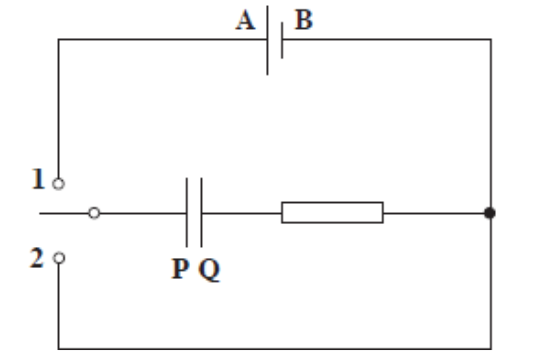
The switch is moved to position 1 until capacitor is fully charged and is then moved to position 2.
Describe what happens in this circuit after the switch is moved to position 1 and after it has been moved to 2. Refer to:
the direction in which electrons flow in the circuit, and how the flow of electrons changes with time
how the potential differences across the resistor and the capacitor change with time
the energy changes which take place in the circuit (6)
Charging
Electrons flow from plate P to terminal A and from terminal B to plate Q
Electrons flow in the opposite direction to current
Plate P becomes +and Q becomes -
The rate of flow of electrons is greatest at the start and decreases to 0 when capacitor is fully charged
Vr decreases from E to 0 whilst Vc increases from 0 to E
at any time Vr + Vc = E
Time variations are exponential decrease for Vr and exponential increase for Vc
Chemical energy of battery is changed into electric potential energy stored in the capacitor and into thermal energy by resistor
Half of energy supplied by batter is converted into thermal, half is stored in capacitor
Discharging
Electrons flow back from plate Q via the shortening wire to plate P
At the end of the process the plates are uncharged
Rate of flow of electrons greatest at the start, decreases to 0 when capcitor is fully charged
Vc decreases from -E to zero and Vr decreases from E to 0
At any time Vc = -Vr
Both Vc and Vr decrease exponentially with time
Electrical energy stored by the capacitor is all converted to thermal energy by the resistor as the electrons flow through it and this energy passes to the surroundings
Time constant of the circuit is the same for discharging as for charging
Explain why the rate of change of pd between the capacitor plates decreases as the capacitor discharges. (2)
Current decreases
Charge is lost more slowly so pd falls more slowly as voltage is proportional to charge
State 2 situations in which a charged particle will experience no magnetic force when plaed in a magnetic field. (2)
It is not moving
It is moving parallel to the magnetic field
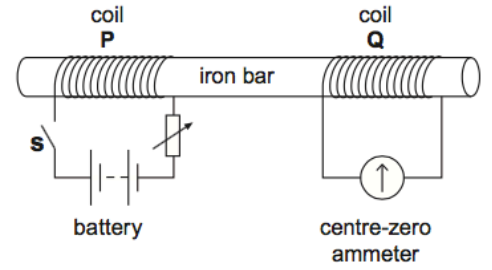
Initially the variable resistor is set to its minimum resistance and S is open. Describe and explain what is observed on the ammeter when S is closed. (3)
With S still closed, resistance of the variable resistor is suddenly increased. Compare what is now observed on the ammeter with what was observed before. Explain why it differs. (2)
Meter deflects than returns to 0
Current produces magnetic flux
Change in flux through Q induces emf
Induced emf causes current in Q
Meter deflects in opposite direction
Flux through P decreases
Induces emf in opposite direction
In the presence of a suitably directed uniform field in a particle accelerator, charged particles move at constant speed in a circular path of constant radius. By reference to the force acting on the particles, explain how this is achieved and why it happens. (4)
Field applied is perpendicular to the path of charged particles
Force acts perpendicular to path of charged particles
Force depends on speed of particles
Force supplies centripetal acceleration towards centre
BQv = mv²/r
The speed of protons in a particle accelerator increases as their energy increases. State and explain how the magnetic field must change as the speed is increased. (2)
Magnetic field must increase
To increase centripetal force
Describe 2 causes of the energy losses in a transformer and dicuss how these energy losses may be reduced by suitable design and choise of materials (6)
1
Ac currents induced in the coils
Coils have resistance
Currents cause heating which results in lost energy
Can be reduced by using low resistance wires
Thick wires of low resistivity have a reduced resistance
2
Ac current in the primary coil constantly magnetises and demagnetises the coil in opposite directions
Energy is required for this
Energy is wasted in heating the core
Choose a magnetically soft material like iron
3
Magnetic flux in the core is changing continuously
Core cut by flux and so emf is induced
These emfs cause eddy currents which heat the core
Laminate core - laminations separated by thin layers of insulator
Currents cannot flow in a conductor that is discontinuous
4
To be efficient as much magnetic flux as possible must pass through the secondary coil
Will not happen if they are widely separated
Magnetic losses can be decreased by having the coils closer together
Better core design
An alternating current supply provides an output voltage of 12V rms at a frequency of 50Hz. Describe how you would use an oscilloscope to check the accuracy of the rms output voltage and frequency of the supply. (6)
Connect oscilloscope to supply
Keep timebase initially turned off
Adjust y-gain to get as long a line as possible
Length of line used to calculate peak to peak voltage
Find rms voltage from this
Timebase turned on and adjusted to get several cycles
Find time period
Frequency = 1/period
Compare measured values with accepted values
What is meant by root mean square voltage? (1)
Square root of the mean of the squares of all the values of the voltage in one cycle
Explain how the cyclotron produces a high-energy proton beam. (6)
Alternating pd
Pd accelerates protons between dees
Magnetic field is perpendicular to the plane of dees
Proton path is curved by the magnetic field
As velocity of protons increases, radius increases
Time for which proton is in a dee remains constant

When the switch is close there is a current in the coil in circuit X. The current is in a clockwise direction as viewed from position P.
Explain how Lenz’s law predicts the direction of the induced current when the switch is opened and again when it is closed. (4)
Induced current opposes change producing it
Switch on:
Current increases flux through Y
Current goes in the opposite direction to crease opposing flux
Switch off:
Flux through Y due to X decreases so current reverses to create flux to oppose this decrease
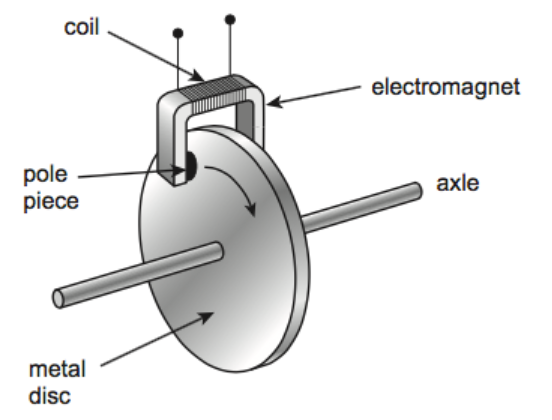
Explain, using the laws of electromagnetic induction, how the device in the diagram acts as an electromagnetic brake. (3)
Current produces magnetic field
Rotating disc cuts flux inducing emf
Induced eddy currents interact with magnetic field
Force on eddy currents slows rotation
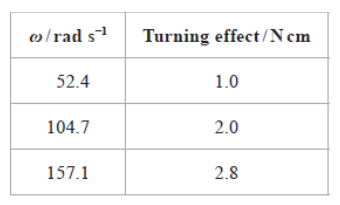
The table shows how the turning effect exerted on a load varies with angular peed for a particular distance between the copper disc and the plastic disc. Explain the trend shown by the data. (4)
Relationship between angular speed and turning effect is proportional
As speed increases, so does rate of change of flux
This increases induced current in copper disc
Which will lead to an increase in force
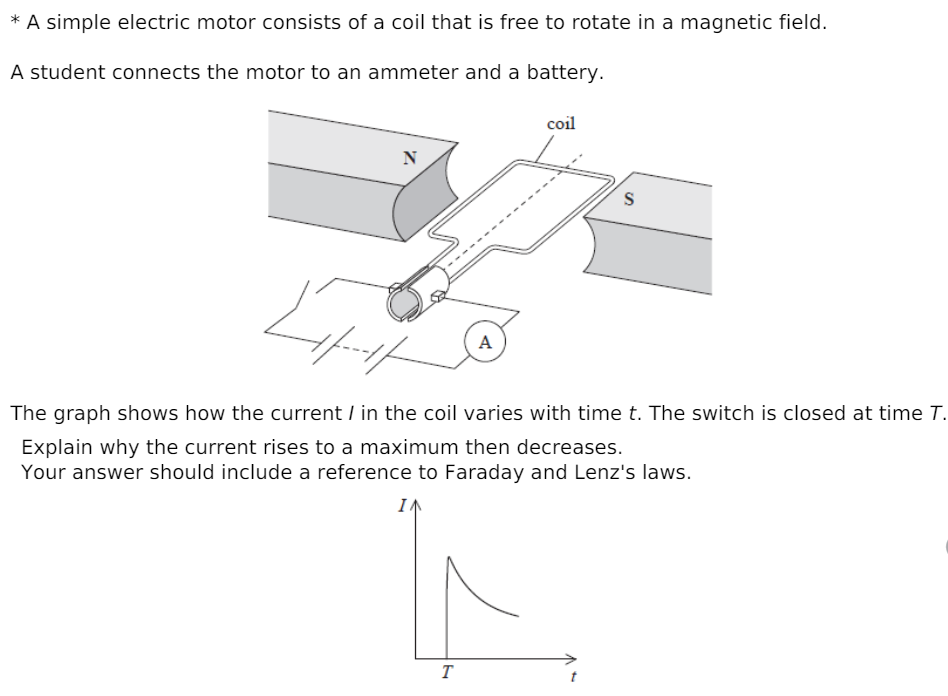
(6)
Initial current is equal to battery emf divided by R
Coil rotates
Coil cuts magnetic flux linkage/there is a rate of change of flux linkage
Which induces an emf
This emf opposes original emf according to Lenz’s law
The faster the coil rotates the larger this emf becomes
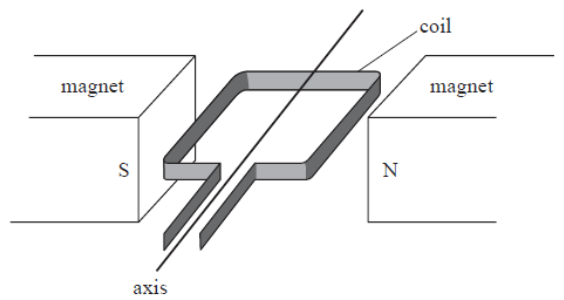
Describe how this hybrid electric vehicle device can be used as both a generator and an electric motor. (6)
Generator
Coil has to be rotated
Change in magnetic flux linkage
Emf proportional to the rate of change of flux linkage induced
Motor
Current provided to coil
Force on coil perpendicular to magnetic field
Coil rotates as forces provide moment
What is meant by the decay constant? (1)
Probability of decay per unit time
Make comparisons between the 2 methods of estimating the radius of a nucleus - Rutherford scattering and electron diffraction. Consider:
the principles on which each experiment is based, including a reference to an appropriate equation
an explanation of what may limit the accuracy of each method
a discussion of the advantages and disadvantages of each method
Alpha scattering involves electrostatic repulsion
Electron diffraction treats the electron as a wave having a de Broglie wavelength
Some reference to relevant equation
Reference to first minimum for electron diffraction
Alphas only measure the least distance of approach, not the radius
Alphas have a finite size which must be taken into account
Electrons need to have a high speed
To have a small wavelength - comparable to nuclear diameter
Requirement to have a small collision region in order to measure the scaering angle accurately
Importance in obtaining monoenergetic beams
Cannot detect alpha particles with exactly 180 degree scattering
Need a thin sample to prevent multiple scattering
Alpha particle measurements are disturbed by the nuclear recoil
Mark for alpha particle measurements are disturbed by the SNF when coming close to the nucleus
SNF not relevant for electrons
Alphas are scattered only by the protons and not all the nucleons that make up the nucleus
Visibility - the first minimum of the electron diffraction is often difficult to determine as it superposes on other scattering events
Define atomic mass unit. (1)
1/12 the mass of an atom of 12-6C
State and explain how the mass of a 4-2He nucleus is different from the total mass of its protons and neutrons when separated. (2)
Separated nucleons have greater mass
Because of binding energy added to separate nucleons
Explain why nuclei in a star have to be at a high temperature for fusion to take place. (3)
Nuclei need to be close together for strong force to be involved
Electromagnetic force is repulsive
If temperature is high then nuclei have high kinetic energies to overcome it